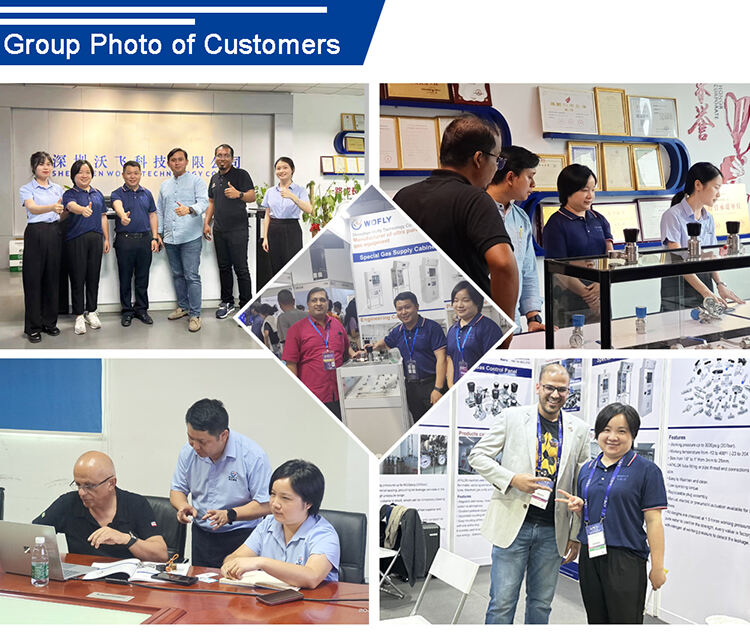Specification
| item |
value |
| Customized support |
OEM, ODM |
| Place of Origin |
China |
|
Guangdong |
| Brand Name |
AFKLOK |
| Model Number |
WL100-02 |
| Type |
Gas Control Panels |
| Material |
SS316 |
| Size |
1/4 |
| Product name |
Gas Control Panels |
| Material |
Stainless Steel 316 |
| Application |
Laboratory |
| Inlet Pressure |
200bar |
| Outlet pressure |
25bar |
| Inlet connection |
1/4"NPT M with 1/4" NPT F flexible hose in 2m |
| Outlet connection |
3/4" ferrule |
| MOQ |
1pcs |
| Suitable gas |
Oxyen/Acetlene/Propane/Nitrogen/Co2 |
| Certificate |
ISO9001 CE |
Company Profile

WOFLY is a leading Manufacturer, Supplier and Exporter of a wide range of gas Equipements, available under the brand name AFK. Wofly's success yields from high-quality, innovative products, exceptional customer service, and unequaled technical expertise in the gas& oil industry. WOFLY offers an extensive line of components including tube fittings, control valves, shut-off and solenoid valves, pressure relief and regulators. Through the years we have learned how to properly match the gas regulation equipment with the application. Using the proper equipment for the job eliminates problems such as contamination, pressure variances, safety issues, and equipment mismatch.

FAQ
- 1. How does a pressure regulator maintain a constant output pressure?
- A pressure regulator maintains a constant output pressure by sensing the downstream pressure and adjusting the flow of the incoming fluid accordingly. If the downstream pressure rises above the desired output pressure, the regulator will restrict the flow to reduce the pressure. Conversely, if the downstream pressure falls below the set point, the regulator will allow more fluid to flow through, increasing the pressure until it reaches the desired level.
- 2. What are the benefits of using a pressure regulator?
- Using a pressure regulator offers several benefits. Firstly, it protects sensitive equipment from exposure to excessive pressure, which can cause damage or malfunction. Secondly, it ensures consistent and reliable performance by maintaining a stable output pressure. This is particularly important in applications where precise control of pressure is crucial, such as in industrial processes or scientific experiments. Additionally, a pressure regulator can help improve energy efficiency by reducing the amount of wasted energy caused by fluctuations in pressure.
- 3. Are there different types of pressure regulators?
- Yes, there are various types of pressure regulators available, each designed for specific applications and pressure ranges. Some common types include spring-loaded regulators, diaphragm-operated regulators, and piston pressure regulators. Spring-loaded regulators use a spring to control the flow of fluid, while diaphragm-operated regulators rely on a flexible diaphragm to sense and adjust the pressure. Electronic pressure regulators use sensors and electronic controls to provide precise and programmable pressure regulation.
- 4. How do I choose the right pressure regulator for my application?
- Choosing the right pressure regulator for your application depends on several factors. You need to consider the maximum and minimum pressure ranges required, the type of fluid you are working with, the flow rate needed, and the specific requirements of your equipment or process. It is also important to select a regulator that is compatible with your system and easy to install and maintain. Consulting with a pressure control expert or manufacturer can help you make the best choice for your specific needs.
- 5. What are the primary material differences between brass and stainless steel pressure regulators?
- The primary difference lies in the materials used. Brass pressure regulators are made of brass, a copper-zinc alloy, which is known for its machinability and corrosion resistance. On the other hand, stainless steel pressure regulators are made of stainless steel, an alloy that contains iron, chromium, and other elements, providing exceptional strength and corrosion resistance.
- 6. How do these material differences affect the performance of the pressure regulators?
- Material choice can significantly impact performance. Brass, while corrosion-resistant, may not be as durable as stainless steel under extreme conditions or when exposed to certain chemicals. Stainless steel, on the other hand, offers superior durability and can withstand harsher environments and chemicals.
AFKLOK
Gas Delivery Systems with Safety Valve Pressure Regulators and Essential Gas Control Panels are designed to provide safe, reliable, and precise gas delivery for a wide range of applications
Created to meet up with the rigorous needs of industrial laboratory and research facilities where accurate and gas.
A state-of solution-the-art is engineered to deliver optimal performance and safety. Prepared with AFKLOK higher level safety features including stress regulators automatic shutoff valves and alarms.
Created to produce exact control over gas flow and crucial stress for applications particularly gas chromatography mass spectrometry. Equipped with high-precision gauges and valves enable users to adjust gas flow and pressure with great accuracy permitting for reproducible and results.
Engineered to provide accurate and stable pressure over the entire range of operation. Designed to keep a constant pressure the outlet even in the face of fluctuations in inlet stress flow or heat.
Built with robust industrial-grade materials and are susceptible to strict procedures to ensure that they meet the highest criteria of safety and dependability. Withstands the most demanding environments.
Contact AFKLOK today to learn more about their gas delivery systems and how they can help you achieve your goals.
